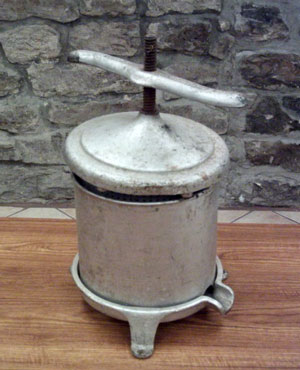In the Archives: The Girl Who Burned
Editor’s note: At its May 20, 2010 meeting, the University of Michigan board of regents approved a $17.7 million expansion of the University Hospital’s emergency department, aimed at reducing overcrowding and patient wait times. In 2009, the hospital’s ER had over 77,000 patient visits. A potential visitor to a UM ER back in the early 1900s would have been Bertha Thorn, the subject of this installment of Laura Bien’s local history column.
The house at 160 North Washington stood dark on the night of December 7, 1908.
The 19-year-old servant girl woke up in her attic room around midnight. She sighed, realizing that she would have to get out of bed and get the chamber pot. It would be cold from the chilly room. Bertha wore a union suit under her nightgown.
She got up and sleepily felt for the kerosene lamp on her bedside table. She lifted the glass chimney and lit the lamp.
The chimney slipped. Bertha grabbed for it. Her nightgown sleeve caught fire.
Bertha jerked back. Her sleeve snagged the lamp. It tumbled and broke on the floor, sending splattered fuel and a column of fire up Bertha’s back. As flames roared up her nightgown, Bertha screamed and ran for the stairs.
“The girl ran shrieking, a pillar of fire, to the hall below,” reported the Dec. 8, 1908 Ypsilanti Daily Press, “where Miss Scovill aroused by her screams overtook her and succeeded with rare presence of mind in wrapping her in a couch throw and extinguished the flames. A physician was summoned and it was found that she was burned from her neck to her feet, the flesh being literally baked on her back, arms, and limbs, although not so severely burned across her chest. The fact that she wore a union suit of heavy underwear made the case more serious as it was almost impossible to remove the garments.”
The paper continued, “The unfortunate girl suffered intensely through the night and this morning on the advice of the attending physician she was removed to the Homeopathic Hospital in Ann Arbor where it is said her chances for life are very slight because of the extent of the surface burned over and the depth of the burns.”
Bertha Thorn was a farmer’s daughter. Born July 28, 1889, she grew up with eight siblings on her parents John and Anna’s farm near Willis in Augusta Township. Bertha attended the nearby one-room schoolhouse. Her education stopped there.
In the fall of 1904, she was 15 years old, of an age to enter high school. She never went – nor did 90% of the children of her generation. In 1901, only 10% of children nationwide attended high school. By 1910, that figure had risen to only 14%, with only 3% obtaining college degrees. A quarter of the population received fewer than 5 years of schooling.
Had she gone, Bertha likely would have attended the nearest high school, in Ypsilanti, and boarded there. She would have graduated with the class of ’07. None of the Ypsilanti High School yearbooks from 1904 to 1907 include her name in the freshman through senior classes.
In the summer of 1908, Bertha found a job in one of the few professions then open to women. She worked as a servant in the home of Henry Scovill, who owned a large lumberyard on Frog Island that, flooded out, later moved nearby to Huron and Jarvis.
It was a humble position but a respectable one. Only a few months into the job came the fire and the agonizing trip to Ann Arbor for help.
Skin grafts in 1908 were done using three methods. Zoografting used skin from a “frog, chicken, pig, dog, cat, rabbit, or guinea-pig,” wrote Stuart McGuire in his 1908 book “Lectures on Principles of Surgery.” McGuire was surgery professor at Richmond’s University College of Medicine (now Virginia Commonwealth University) and later its dean and chair of surgery.
The autograft method used a small section of skin taken from another area on the patient’s body. For the immense burn covering Bertha’s back, this would be impossible.
The last method was heterografting, which used skin from fresh cadavers. “They usually grow well and should be employed when they can be secured from a satisfactory source,” said McGuire in “Lectures.” “They entail the danger of infecting the patient with syphilis, and other diseases which must be carefully guarded against.”
McGuire then reflected on a question that many other surgeons wondered about in his era, a question that reveals the frightening lack of knowledge of surgeons then performing skin grafts. Using language of his day, he wrote, “The question of the necessity of the graft being of the same color as the skin of the patient on which they are planted is still unsettled. It is claimed that a negro’s skin grafted on a white person will lose its pigment and that a white skin grafted on a negro will become pigmented.”
It seemed almost a cruel joke to predict that Bertha would survive. On April Fool’s Day, 1909, she was released from the hospital to rest at home.
Bertha rode a wagon over washboard dirt roads back to Willis. “She stood the journey very well,” said the April 1, 1909 Ypsilanti Daily Press.
The paper continued, “Since she has been in the hospital she has submitted to several skin grafting operations, one being on her right arm. During her illness she has suffered intensely and has been obliged to lie on her face all the time because of the injuries to her back.”
On April 11, 1911, Bertha married John Wagner. She had her first child, James, eight months (minus one day) later.
The Wagners moved to Milford where John worked as a farm laborer. Bertha had a son, George, in 1915 and a daughter Angeline in 1919. A year later son Fred was born, with Russell following in 1924, when Bertha was 35. She had one more son, Frank, who did not survive.
The family moved back to Ypsilanti, where John worked for years at the Central Specialty Company, which produced metal parts and plumbing fixtures. The couple bought a house on Holmes Road just northeast of the city.
Patched together long ago with cadaver skin in an era of often questionable medicine, Bertha outlived her husband. Nearly a half-century after Ann Arbor doctors had saved her life, Bertha died on August 9, 1955, at 66 years old.
She is buried in Union-Udell cemetery.
This biweekly column features a Mystery Artifact contest. You are invited to take a look at the artifact and try to deduce its function.
In the last column cmadler and ABC correctly guessed that the Mystery Artifact was an automated milk delivery note. Instead of leaving a note in a milk bottle on the porch for the milkman to see, the device, stuck in the neck of a milk bottle, allowed you to display selected tabs indicating extra dairy items you wanted this week.
Lots of folks chimed in with quite charming memories of milk chutes in old-time Ann Arbor.
This week’s Mystery Artifact pays tribute to those long-time residents with an artifact that veteran Ann Arborites will likely recognize (though it’s the Ypsi version). Take your best guess and good luck!
Laura Bien is the author of “Tales of the Ypsilanti Archives.” Contact her at ypsidixit@gmail.com.






Looks like some sort of fruit squeezer to help in making juice.
Mr. Dokas: That is an interesting guess. It certainly is heavy. Fitting within the barrel is a cylindrical colander.
It is a press of some sort. You can see the screw to apply pressure and the drain at the bottom. I’ll guess it was used to ring cloths after washing.
Skeg: Another good guess. I would guess that this item would have a little over a gallon in capacity.
Is it a sauerkraut press?
Ms. Lowenstein: Another good guess. And one thing I always wanted to try. My experiment with pickling vegetables in a crock was…interesting, in a frightening sort of way.
Building on the guesses of Phil Dokas and Skeg, I’ll guess that it’s a cider press for juicing apples.
cmadler: Yet another good guess. It’s a tough tool made for some mighty hard work, that’s for sure. There are holes in the feet with which to bolt it to a surface.
With a little help from your hints, I would venture that a mass of curds wrapped in cloth would be placed inside this device in order to squeeze out the whey, later to be hung and aged for a tasty block of cheese.
Was it used to grind coffee beans to make coffee?
Cosmonican: That’s funny, I was just reading about cheese presses today in a book about home life in colonial times. Very labor-intensive, but nowhere near as labor-intensive as processing flax! There are at least 40 steps to the latter…sheesh.
Wendy: Still another good guess; looks like that, doesn’t it?
Personal sized extra extra extra oh, heck, extra virgin olive oil press?
Mr. Richards: Yes, the area is famous for its pioneer stands of…….olive trees….. :D :D
That was an amazing article. Made my skin crawl. I love it when I get a physical reaction from reading something.
Andrew: Thank you for your comment. I was astounded to learn of the scale of the operation…so early in the century. A few scattered descriptions of the agonizing pain made me realize how badly she suffered (shudder).
Yet she did, amazingly, survive and go on to get married and have kids…I imagine that even today with modern medicine such a good recovery would be seen as pretty amazing.
Laura,
It is definately a fruit press, made for mainly apples. I remember my grandmothers, that always sat in her kitchen next to her fruit canning jars and lids. We used to help her turn the handle and watch the juice flow out of the bottom into a large bowl. She made the best cinnimon apple sauce I ever tasted. Great memories I had almost forgotten.
Dave: What a wonderful memory. That sounds absolutely delicious. We always pick apples in the fall and dry ‘em but I never thought to make applesauce. Might have to try it.